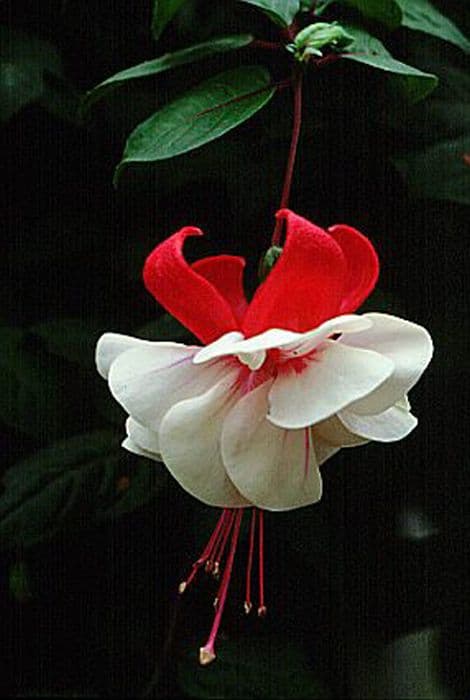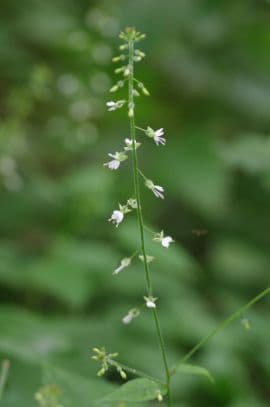Fuchsia Fuchsia 'Ballet Girl' (d)

ABOUT
Fuchsia 'Ballet Girl' is a delightful plant that is widely admired for its unique and attractive flowers. The blossoms of this variety are particularly eye-catching, with a graceful appearance that is reminiscent of a dancer, hence the name 'Ballet Girl'. The flowers typically feature a lovely combination of colors, with petals that are usually a blend of pink and purple hues, and can sometimes have white accents. These petals dangle elegantly from slender stems, creating a delicate, flowing effect similar to a ballet dancer's tutu. The foliage of Fuchsia 'Ballet Girl' consists of lush green leaves that provide a vivid backdrop for the vibrant flowers. The leaves are often oval-shaped with a slightly serrated edge, giving them a textured look. Together, the green of the leaves and the pink-purple tones of the flowers make for a striking contrast. This fuchsia plant is grown for its ornamental qualities, with the blooms typically appearing in the warmer months. It is popular for hanging baskets and garden containers, where its trailing growth habit allows the flowers to spill over the edges, creating a beautiful, cascading display. The plant can also attract hummingbirds, adding another layer of charm to its presence in a garden or on a patio. Overall, Fuchsia 'Ballet Girl' is a captivating addition to any space that seeks to add a touch of elegance and vibrant color.
About this plant
 Names
NamesFamily
Onagraceae
Synonyms
Ballet Girl Fuchsia
Common names
Fuchsia 'Ballet Girl'
 Toxicity
ToxicityTo humans
Fuchsia is not considered toxic to humans. In fact, the berries of some fuchsia species are edible. However, as with any plant, individual allergic reactions or sensitivities are possible. If symptoms of such a reaction appear, medical advice should be sought.
To pets
Fuchsia is generally considered non-toxic to pets including dogs and cats. It is not known to cause serious illness or death if pets consume parts of the plant. However, gastrointestinal upset such as vomiting and diarrhea are possible if pets ingest significant amounts of the plant. If any severe symptoms occur, contact a veterinarian.
 Characteristics
CharacteristicsLife cycle
Perennials
Foliage type
Deciduous
Color of leaves
Green
Flower color
Mixed
Height
1-2 feet (30-60 cm)
Spread
1-2 feet (30-60 cm)
Plant type
Shrub
Hardiness zones
9
Native area
Central and South America
Benefits
 General Benefits
General Benefits- Aesthetic Appeal: Fuchsia 'Ballet Girl' has delicate, pendulous flowers that add a splash of vibrant color to gardens and outdoor spaces, enhancing visual interest.
- Attracts Pollinators: Its brightly colored flowers attract hummingbirds and butterflies, helping to promote pollination in the garden.
- Versatility: This plant can be used in hanging baskets, containers, or as part of a mixed border, providing flexibility in garden design.
- Long Flowering Season: Fuchsias have a lengthy blooming period that can last from spring through fall, ensuring a long-lasting display of flowers.
- Shade Tolerance: They can thrive in partial shade, making them a good choice for shaded areas where other sun-loving plants might not grow as well.
- Easy Propagation: They can be easily propagated from cuttings, allowing gardeners to create more plants for use in other areas or to share with friends.
- Relatively Pest-Free: Fuchsias are generally free from major pest problems, reducing the need for chemical pest controls in the garden.
 Medical Properties
Medical PropertiesThis plant is not used for medical purposes.
 Air-purifying Qualities
Air-purifying QualitiesThis plant is not specifically known for air purifying qualities.
 Other Uses
Other Uses- Fuchsia 'Ballet Girl' can be employed as a natural dye for fabrics, giving textiles a soft purple or pink tint depending on the mordant used.
- The vivid flowers of the fuchsia can be used to create artistic arrangements and pressed flower crafts, preserving their beauty in a different form.
- The plant's drooping flowers can inspire designers and artists in creating jewelry and decorative items that mimic its unique shape and colors.
- Fuchsia flowers can be incorporated into homemade potpourris for a subtle color accent and a light, fresh fragrance when dried.
- These plants can be cultivated in hanging baskets to create living curtains for privacy on patios or in garden spaces.
- The nectar-rich flowers may serve as an educational tool for biology classes studying pollination and the role of hummingbirds and insects in ecosystems.
- Fuchsia sap can sometimes be used in traditional crafts for a temporary plant-based glue when a mild adhesive is needed.
- Culinary enthusiasts can use the non-toxic flowers of fuchsia as a decorative, edible garnish in exotic dishes and cocktails.
- The plant can serve as a photography subject for artists focusing on macro photography, capturing the intricate details and color gradations of the flowers.
- Leaves from the fuchsia can be used in creative projects for kids, such as leaf rubbing art, helping children learn textures and patterns in nature.
Interesting Facts
 Feng Shui
Feng ShuiFuchsia is not used in Feng Shui practice.
 Zodiac Sign Compitability
Zodiac Sign CompitabilityFuchsia is not used in astrology practice.
 Plant Symbolism
Plant Symbolism- Elegance and grace - The delicate petals and poised appearance of the Fuchsia plant can symbolize elegance and grace, echoing the poise and refinement of a ballet dancer.
- Confiding love - Fuchsia flowers are sometimes associated with confiding love, where the handing over of the flower represents a deep-felt, trusting relationship.
- Good taste - With its exquisite flower shapes and vivid colors, the Fuchsia can represent good taste or appreciation of aesthetic beauty.
- Acknowledgement of accomplishment - The name 'Ballet Girl' itself can be symbolic of accomplishment and the result of hard work, similar to a ballet dancer's achievements.
- Amiability - Historically, Fuchsia has been connected to amiability, indicating a warm, friendly, and approachable disposition.
 Water
WaterThe hardy fuchsia, including the 'Ballet Girl' variety, prefers consistently moist soil, so regular watering is essential. Aim to water the plant thoroughly when the top inch of soil feels dry to the touch, which typically translates to approximately once or twice a week, depending on weather conditions. Use a watering can or hose to gently water at the base of the plant, avoiding wetting the foliage to reduce the risk of disease. Each watering session should provide enough water to saturate the root zone; for potted 'Ballet Girl' plants, this could mean using around 16-24 ounces of water every few days during active growth periods, making adjustments based on rainfall and temperature.
 Light
LightHardy fuchsias, such as 'Ballet Girl', flourish in partial shade to dappled sunlight. The ideal location would be one where the plant receives morning sun and afternoon shade, or filtered light throughout the day. Avoid full, direct afternoon sunlight, especially in hotter climates, as it can scorch the leaves and stress the plant.
 Temperature
TemperatureHardy fuchsia 'Ballet Girl' grows best in temperatures between 60°F and 75°F, which are ideal for encouraging blooming and healthy growth. Although this plant can survive temperatures as low as 0°F for short periods, prolonged exposure to temperatures below 25°F could be fatal. For optimal growth and flower production, keep 'Ballet Girl' fuchsia within this temperature range and protect it from extremes.
 Pruning
PruningPrune 'Ballet Girl' fuchsia to maintain plant shape and encourage bushier growth. Remove dead or damaged branches and spent flowers to enhance vigor and appearance. Pruning is best done in late winter or early spring before new growth starts. For rejuvenation, cut back the plant by one-third to one-half every few years.
 Cleaning
CleaningAs needed
 Soil
SoilThe best soil mix for Fuchsia, commonly known as Lady's Eardrops, should be rich in organic matter, well-draining, and slightly acidic to neutral, with a pH range of 6.0 to 7.0. A combination of peat moss, loam, and perlite or sand can provide these conditions, promoting healthy growth.
 Repotting
RepottingLady's Eardrops should be repotted annually, preferably in the spring before new growth begins. This helps to refresh the soil, provide more room for root development, and remove any built-up salts.
 Humidity & Misting
Humidity & MistingLady's Eardrops thrive best in moderate to high humidity levels, ideally around 60-70%. They benefit from a humid environment but can tolerate a range from 50% to high humidity if other care needs are met.
 Suitable locations
Suitable locationsIndoor
Keep in bright, indirect light, and high humidity.
Outdoor
Grow in dappled shade, shelter from strong winds.
Hardiness zone
10-11 USDA
 Life cycle
Life cycleFuchsia 'Ballet Girl' starts its life cycle when its seeds are sown in fertile, well-draining soil in spring after the danger of frost has passed. The seeds germinate, and young seedlings emerge, which are then thinned and transplanted if necessary. As a young plant, it requires adequate water, partial shade to full sunlight, and regular feeding to grow into a bushy shrub. The plant reaches maturity and begins to produce distinctive, pendulous flowers, usually in the late spring to early summer, attracting pollinators such as hummingbirds and bees. After pollination, the flowers develop into small fruiting bodies containing seeds. The life cycle can begin anew when these seeds are dispersed and if conditions are favorable, they will germinate to produce a new generation of plants; in colder climates this plant is often treated as an annual, although it can be overwintered indoors in some cases.
 Propogation
PropogationPropogation time
Spring-Early Summer
Fuchsia 'Ballet Girl', commonly referred to simply as Fuchsia, can be readily propagated through softwood cuttings, which is the most popular method. This technique is ideally performed during the spring or early summer when the plant is actively growing. Take a cutting of 2 to 4 inches (5 to 10 cm) in length, making sure it has a few leaves, and remove the lower leaves nearest to the cut end. Dip the cut end into rooting hormone powder to enhance root development. Then, plant the cutting into a mix of peat and perlite or a well-draining potting mix, ensuring at least one node (where the leaves were removed) is below the soil line to encourage roots to develop from that point. The cutting should be kept in a warm area with indirect light and maintained humid by placing a plastic bag over it or using a propagator. Roots typically form within a few weeks, at which point it can gradually acclimate to less humid conditions and eventually be planted in a permanent location.






![Fuchsia [Electric Lights]](/_next/image?url=https%3A%2F%2Fplants-admin.emdemapps.com%2Fimages%2Fplants%2F%2Fimages%2F604b5ba9b6455.png&w=640&q=75)


